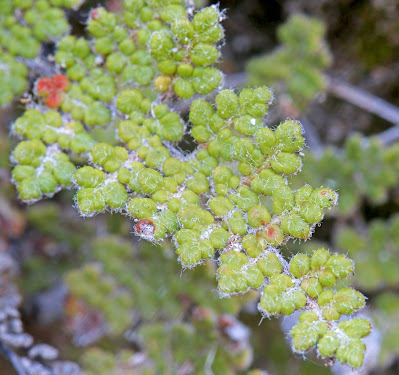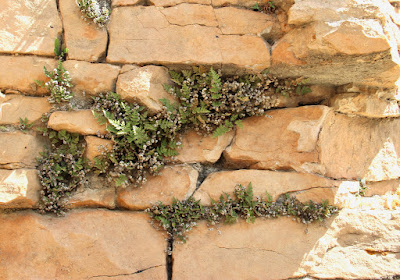 |
| Slender lip fern, Cheilanthes feei, on limestone. |
Ferns are commonly considered inhabitants of cool shady humid locations with lush green vegetation—tropical forests, temperate marshes, wooded stream banks, heavily-shaded north-facing slopes, and such. However if this were the case, South Dakota would have just seven species of ferns.
But this is not the case. There are 26 fern species in South Dakota, and the additional 19 are especially interesting. All are xerophytes, i.e., drought-tolerant. And all can grow on rock. In fact, 14 are restricted to rock. This is very different from the global situation. Worldwide, drought-tolerant ferns are in the minority.
One of the most common drought-tolerant ferns in South Dakota is the slender lip fern, Cheilanthes feei, also called Myopteris gracilis (1). It is a widespread North American species, ranging from northwest Canada to northern Mexico, and from the Pacific coast through the Midwest, with several widely disjunct populations in Kentucky, Virginia, and North Carolina.
One of the most common drought-tolerant ferns in South Dakota is the slender lip fern, Cheilanthes feei, also called Myopteris gracilis (1). It is a widespread North American species, ranging from northwest Canada to northern Mexico, and from the Pacific coast through the Midwest, with several widely disjunct populations in Kentucky, Virginia, and North Carolina.
 |
| Cheilanthes feei, Yavapai Co., AZ. Patrick Alexander photo. |
 |
| Thick covering of hairs on underside of Cheilanthes feei leaflets. Patrick Alexander photo. |
 |
| Beadlike segments are characteristic of Cheilanthes feei. Andrey Zharkikh photo. |
The slender lip fern is a fine example of drought tolerance, with many traits characteristic of xerophytic ferns. To reduce water loss, undersides of leaves (fronds) are covered in hairs; upper surfaces have a thickened cuticle. If this isn't enough, the fern can dry out yet remain viable, able to rehydrate when moisture returns. But perhaps its most interesting xerophytic adaptation is abstinence. Yes, abstinence! The slender lip fern forgoes sex.
To proceed further requires review of the basic fern life cycle, the supposed "bugbear of many introductory botany students" (Moran 2004). Actually it's not that difficult if you don't have to remember all the terms and details for an exam.
In the diagram above, note the two stages—two free-living organisms. One is the familiar leafy fern plant (right), which produces spores, making it a sporophyte. A spore germinates to produce the other stage, a tiny leafless rootless prothallus (lower left). This is a gametophyte, which produces gametes—ovules (eggs) and sperm. The prothallus is where sex happens, where a sperm swims to an ovule for fertilization (a thin film of water will suffice). From the resulting zygote grows a young leafy fern sporophyte.
This is the common version of the fern life cycle. However, 5–10% of fern species have abandoned sex (Moran 2004). They do this by skipping gamete production and fertilization, as indicated in pink in the modified life cycle below. These ferns are said to be apogamous—without gametes. And as it happens, many of them live in dry habitats.
Apogamous ferns do produce spores, and these germinate to become prothalli. But these particular prothalli are not gametophytes. They are very small short-lived structures with no sexual organs. Instead, a baby sporophyte soon appears, sending down roots and growing leaves. If it survives, it becomes a familiar spore-producing fern. This approach has obvious advantages in dry habitat. The ephemeral prothallus doesn't have to stay moist for long. And there are no sperm needing to swim off in search of sex.
Apogamous ferns do produce spores, and these germinate to become prothalli. But these particular prothalli are not gametophytes. They are very small short-lived structures with no sexual organs. Instead, a baby sporophyte soon appears, sending down roots and growing leaves. If it survives, it becomes a familiar spore-producing fern. This approach has obvious advantages in dry habitat. The ephemeral prothallus doesn't have to stay moist for long. And there are no sperm needing to swim off in search of sex.
How did such a situation evolve? It's tempting to conclude that sex was abandoned in response to selection for drought tolerance. But there's another "reason" to consider. The slender lip fern, like many apogamous ferns, is triploid. Instead of the usual two sets of chromosomes (diploid), it has three, making successful sex impossible. Three sets of chromosomes can't be divvied up equally, and the resulting ovules and sperm can't properly pair (2). If sex does happen, the result is misshapen aborted spores.
 |
| For the slender lip fern, which came first—drought tolerance or apogamy? |
Notes
(1) Our standard sources—e.g., ITIS, Flora of North America, USDA PLANTS—all list Cheilanthes feei as the accepted name for the slender lip fern. However, in a revision of the genus Cheilanthes, Grusz and Windham (2013) gave it back its old name, Myriopteris gracilis (not a reclassification but nomenclatural fix).
(2) Successful sex in this context is the union of gametes (ovules and sperm) through fertilization. Gametes are products of meiosis, a form of division that creates cells each with a single set of chromosomes (haploid). Then fertilization restores the diploid state. However, the slender lip fern, being triploid, can't produce viable gametes because there's no way to equally divvy up three sets of chromosomes. If meiosis were to take place, each gamete would get one full set of chromosomes but then various ones from the third set. These random chromosomes can't match up during fertilization.
Sources
Crow, WE, et al. 2011. Narrow substrate niche of Cheilanthes lanosa, the Hairy Lip Fern, is determined by carbohydrate and lipid contents in gametophytes. American Fern Journal 10:57–69.
Diamond, H, and Swatzell, L. 2003. Cultivation of Myriopteris (formerly Cheilanthes) species (with focus on M. gracilis and M. lanosa). American Fern Society webpage.
Moran, Robbin. 2004. A Natural History of Ferns. Timber Press.



Oh, you get the ferns! Lucky you! They're so fascinating and diverse.
ReplyDelete